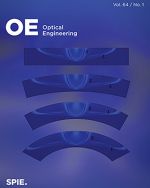Resources / Research & Innovation Center / Publications
Collimated laser homogenizer
Michael Scaggs, Gilbert Haas
Abstract
A new laser beam homogenizer has been developed which converts a highly spatial coherent, Gaussian laser beam into a collimated, square homogenized field. The optical device converts a laser’s Gaussian input beam through multiplexing and recombination without optical interference and yet is collimated over > 5 meters. Laser beam property variations do not adversely affect the performance of the homogenizer in contrast to phase shifting homogenizers and can be utilized from the laser’s objective lens’ entrance pupil to its focus while maintaining the relative degree of homogenization. The degree of homogenization is limited only by diffraction effects and the input diameter of the laser beam.


